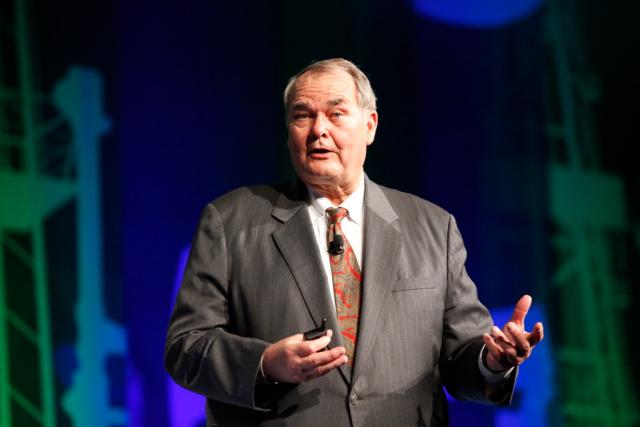
Randy Foutch, CEO, Laredo Petroleum Inc., speaks at the 2015 DUG Permian Basin conference. He also spoke again in 2017. (Source: Hart Energy)
FORT WORTH, Texas—While speaking at Hart Energy’s DUG Permian Basin conference on April 5, Randy Foutch, founder, chairman and CEO of Laredo Petroleum Inc., hit some familiar themes on the challenges U.S. producers face. The industry veteran quoted Saudi Arabia’s Ali al-Naimi, who observed at CERA Week in 2016 while he was still minister for energy, industry and mineral resources that upstream firms have only three options: “lower costs, borrow cash or liquidate.”
The Saudi minister failed to observe producers “can get very good at what you do,” Foutch said. “U.S. producers did not collapse, to the surprise of many” when Saudi and its fellow OPEC members opened their valves and flooded the world’s oil market to maintain market share in late 2014.
Why? Because the U.S. upstream operators have become very proficient at what they do—and are getting better, Foutch said.
“Today, 395 rigs can add the same production it took 641 rigs to add in 2014,” he said. “That’s what people missed. Costs directly reduced the breakeven point.”
Foutch explained that better initial production performance, high-grading of prospects and shorter drill times created success unexpected by OPEC. That allows producers to function profitably in a market paying $40-$50 per barrel (bbl) for West Texas Intermediate. He said the breakeven point in the nation’s shale plays has fallen from $69/bbl in 2012 to $40/bbl in 2016—and continues to fall. “Completion optimization and drilling efficiencies drove capital efficiency in U.S. shale plays,” he added.
The unconventional shale plays now produce 47% of U.S. crude output, and by next year the Permian Basin alone will supply 27% of the nation’s oil. U.S. production continues to rise. And Foutch noted that, if Texas were a separate nation, it would have ranked No. 8 in oil output last year, midway between oil powerhouses Iran and the United Arab Emirates.
For its part, Laredo has been successful by pursuing a three-point formula:
- Build a contiguous acreage position that enables capital efficiencies;
- Collect the data to power its “Multivariate Earth Model;” and
- Invest in infrastructure to lower costs and ensure the ability to move oil and gas to price-advantaged markets.
Foutch pointed out that Laredo has nearly 125,000 net acres in the Midland Basin, primarily in Glasscock and Reagan counties, Texas, on adjoining blocks. Some 85% of those leases are held by production. Laredo drills within that acreage along tightly defined “production corridors” that allow the firm to cut drilling, completion and operating expenses using closely spaced, multi-well pads with excellent infrastructure.
“This allows us to cut costs and it dramatically changes our EURs,” he said.
Laredo currently has more than 2,000 identified drilling locations along those corridors. They are not picked at random, or even by educated guesses, Foutch emphasized. “Earth modeling is one of a number of technologies being applied at Laredo to enhance shareholder value,” he said, explaining that each potential location is benchmarked against 70 criteria for potential success, from geology to pipeline proximity.
While Laredo is not a midstream company, it recognizes that infrastructure can have a dramatic impact on cost containment, he said.
“This reduces time from production to sales,” Foutch explained. “The benefits of our system increase as trucking costs rise. Laredo’s oil gathering system eliminated some 41,000 truckloads of oil in 2016.” Pipelines are cheaper than trucks—and more dependable “when it does rain in West Texas,” he added with a chuckle.
All told, those three corporate goals enabled Laredo to reduce unit lease operating expense by 53% from first-quarter 2015 to fourth-quarter 2016—with further improvements expected this year.
“These are important advantage as we see the world changing,” Foutch said. “And it’s repeatable, again and again.”
Paul Hart can be reached at pdhart@hartenergy.com, or @twopdhart.
Recommended Reading
Vår Energi Hits Oil with Ringhorne North
2024-04-17 - Vår Energi’s North Sea discovery de-risks drilling prospects in the area and could be tied back to Balder area infrastructure.
Tethys Oil Releases March Production Results
2024-04-17 - Tethys Oil said the official selling price of its Oman Export Blend oil was $78.75/bbl.
Exxon Mobil Guyana Awards Two Contracts for its Whiptail Project
2024-04-16 - Exxon Mobil Guyana awarded Strohm and TechnipFMC with contracts for its Whiptail Project located offshore in Guyana’s Stabroek Block.
Deepwater Roundup 2024: Offshore Europe, Middle East
2024-04-16 - Part three of Hart Energy’s 2024 Deepwater Roundup takes a look at Europe and the Middle East. Aphrodite, Cyprus’ first offshore project looks to come online in 2027 and Phase 2 of TPAO-operated Sakarya Field looks to come onstream the following year.
E&P Highlights: April 15, 2024
2024-04-15 - Here’s a roundup of the latest E&P headlines, including an ultra-deepwater discovery and new contract awards.





